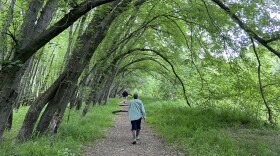Watching fireflies is one of the singular pleasures of a warm summer night. Many of us have fond memories of watching them flit about and even catching them in a jar to observe their flashes more closely.
“It reminds me of when I was young and going outside at night was a real adventure,” says Something Wild host Chris Martin of NH Audubon.
“As kids, we'd run through the backyards, catching them in glass Skippy peanut butter jars with holes punched into metal lids," says Dave Anderson of the Forest Society and Something Wild host.
"We released them after watching them climb and flash inside the glass. Even today, the smell of peanut butter can conjure that memory for me.”
Many areas of the country are reporting greater numbers of fireflies this summer, but you may also have seen a recent headline speculating that we might be the last generation to have the opportunity to enjoy twinkling fireflies.
Fireflies are declining all over the world, losing habitat due to development and increased light pollution.
So why so many fireflies this summer?
You may recall that this past spring was the third wettest since records were kept in New Hampshire. All that moisture kept the soil wet and warm, creating perfect breeding conditions for fireflies.
They spend up to two years growing underground as larvae, until they finally pupate and then become adults.
Fireflies live in soil and leaf litter. They love marshy areas and regions near the edges of ponds, lakes, streams and other bodies of water.
When the soil is damp, as it was this spring, there are more snails, slugs, and pill bugs, favored foods for firefly larvae. The larvae get bigger faster, more survive to adulthood, and adult fireflies emerge earlier.

Fireflies are actually not a fly but a type of beetle, classified under Lampyridae, a family of insects within the beetle order Coleoptera, or winged beetles.
And not everyone in the US gets to experience twinkling fireflies on a summer night.
There are two other kinds of fireflies found mostly west of the Rockies: daytime dark fireflies, which are active during the day and don’t produce light, and glow-worm fireflies, whose flightless females glow.
New Hampshire is home to at least 15 species of fireflies, also called lightning bugs.
Read an ode to fireflies by the Harris Center's Susie Spikol in Yankee Magazine
Adult fireflies only live 2-4 weeks. They are all about reproduction; some don’t even eat during their adult stage.
The flash that fireflies produce is a chemical reaction inside their abdomens. The rhythm and color of their flashes are a signal to find a mate, indicating what species and sex they are.
As they breathe in oxygen, they modulate the flash they produce by regulating the amount of oxygen they take in.
One species, found in New Hampshire, can even mimic the mating flashes of the female of another species. That fools the male of the species into approaching, and with paralyzing neurotoxins, the female consumes the male. His defensive toxins make her more resistant to predators. She even passes her resistance down to her female offspring.
Fireflies thrive under low-hanging trees, in forests and fields, and even in your yard or vegetable garden. They spend their time in tall grass, and are born and raised in the decaying leaves and vegetation naturally on the forest floor. They also like rotting logs, where they often find their prey.

If you would like to create a firefly-friendly habitat, just let it be “something wild” with rotting logs and decomposing leaves in the mix. You can do less clearing and tidying-up of nature, to preserve the habitat they need and so their larvae, and other small insects, can survive.
You don’t have to abandon your garden and lawn, just leave some untamed area. Gardens with heavy mulch prevent weeds, but they also prevent firefly females from laying eggs directly in the soil, and make it harder for larvae to get to those snails, earthworms, and other insects they need for food.
And avoid broad spectrum pesticides; it harms not only the fireflies at every life stage, but also the things they eat.
New Hampshire resident and poet Robert Frost undoubtedly watched fireflies on a summer night. We know because in 1928 he published “Fireflies in the Garden.”
“Here come real stars to fill the upper skies,And here on earth come emulating fliesThat though they never equal stars in size,(And they were never really stars at heart)Achieve at times a very star-like start.Only, of course, they can't sustain the part.”
Fireflies are a cherished part of the summer experience in New Hampshire. When you go out to look for fireflies, turn off the outdoor lights – that’s also beneficial for birds, and for seeing the stars, too.
If we’re careful, we won’t be the last generation to experience the miracle of twinkling fireflies.
Something Wild is a partnership between NH Audubon, the Forest Society, and NHPR.











